Sprinter (British Rail)
The Sprinter is a family of diesel multiple unit trains in use on the British railway system. They were built in the 1980s and early-1990s by British Rail Engineering Limited (BREL), Metro Cammell and Leyland. Most have Cummins engines with Voith hydraulic transmissions, although 47 Class 158 units have Perkins engines instead. Sprinters can be seen operating in almost every part of Great Britain, from rural branch lines to commuter expresses into major cities.
| Sprinter (train) | |
|---|---|
 | |
| In service | 1984-present |
| Family name | Sprinter |
| Number built | 556 trainsets |
| Operator(s) | |
| Specifications | |
| Maximum speed | 75 mph (121 km/h) (Class 150, 153, 155, 156) 90 mph (140 km/h) (Class 158, 159) |
| Track gauge | 1,435 mm (4 ft 8 1⁄2 in) standard gauge (UK trains) 1,000 mm (3 ft 3 3⁄8 in) metre gauge (Thailand trains) |
Originally British Rail coined the "Sprinter" name for the units, mainly to promote the superior acceleration capabilities of the units compared with the first-generation DMUs they replaced. Advertisements such as "The Sprinters are coming" were locally advertised in newspapers when these trains were scheduled to be introduced. Great play was also made of, in many cases, reduced journey times.
Background
At the beginning of the 1980s, British Rail (BR) had a large fleet of ageing "Heritage" DMUs built to many different designs in the late-1950s and early-1960s. Some of the more reliable types were retained and refurbished. BR decided to replace many of the non-standard or unreliable types with new second-generation units, built to modern standards. Two types were developed: low-cost "Pacers", built using bus parts and intended for short-distance services; and "Sprinters", for use on longer-distance services.[1]
Prototypes
Two companies, BREL and Metro-Cammell, built 2 x three coach prototypes for the first batch of Sprinters, the Class 150/0 and Class 151.
| Class | Image | Top speed | Number | Built | Notes | |
|---|---|---|---|---|---|---|
| mph | km/h | |||||
| 150/0 |  |
75 | 121 | 2 | 1984 | One of these BREL prototypes was very similar to the production Class 150 units, with a Cummins engine and Voith gearbox. The other was fitted with a Rolls-Royce engine and Self Changing Gears (SCG) transmission. The latter unit would suffer various problems with both of these components, but would later become the only Class 154 and was used as a Class 158 testbed.[2] |
| 151 | 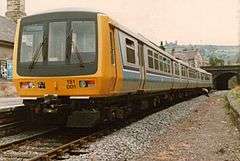 |
1985 | Built by Metro-Cammell, these featured the same Cummins engine as the Class 150. They had aluminium body shells and American Twin Disc hot-shift gearboxes. They suffered from a jerky, violent gearshift, which was never fully rectified. BREL's Class 150 design won the contract from British Rail, and the Class 151 never entered production.[3] | |||
| 154 |  |
90 | 145 | 1 | A class of a single unit, this unit had been converted from a Class 150 prototype, fitted with a different engine and gearbox to the production Class 150s. It became a Class 158 testbed; its problematic gearbox was replaced with an improved American Twin-Disc hot shift transmission with different control software, which finally resulted in smooth gear-changes, and air conditioning was also fitted. Converted back to a standard Class 150.[4] | |
Production units
| Class | 1 car Set | 2 car Set | 3 car Set | Total Sets | Total Cars |
|---|---|---|---|---|---|
| Class 150 | – | 132 | 2 | 134 | 273 |
| Class 153 | 70 | – | – | 70 | 70 |
| Class 155 | – | 7 | – | 7 | 14 |
| Class 156 | – | 114 | – | 114 | 228 |
| Class 158 | 147 | 21 | 168 | 357 | |
| Class 159 | – | – | 30 | 30 | 90 |
| Totals | 70 | 397 | 56 | 523 | 1032 |
The production units were all built as two coach units, with the exception of 17 Class 158s and the 22 Class 159 units, which were built with an additional centre car. The Class 153 railcars were converted from the two coach Class 155s.
Class 150, 153, 155, and 156 units have no air-conditioning and a top speed of 75 mph (121 km/h); Classes 158 and 159 have air conditioning and a top speed of 90 mph (145 km/h). All units except the first two batches of Class 150s have outer-end gangways, allowing passengers to walk between trains working in multiple.
All trains in the Sprinter family have BSI couplers which allow them to work in multiple with any other trains in the Sprinter family and also Class 142, Class 143, Class 144 and Class 170 units. However, they cannot work in multiple with Class 165 or Class 166 units due to incompatible wiring arrangements.
Class 150 Sprinter
These were designed as commuter units and are fitted with 5 abreast seating and doors fitted at 1 and 2 thirds down the length of each car, unique amongst the Sprinter family. Early units had no end gangway, therefore in multiple-working with other Sprinter units passengers can not move between units. The 150/2s do feature end gangways, as well as two-by-two airline seating.
Class 950
In addition to the standard Class 150 units, a single two-car DMU was constructed using the same bodyshell for use as a track assessment unit on stretches of line where heavier stock cannot be safely used. This unit was initially classified as Class 180, but was reclassified in the departmental series as Class 950 upon the entry into service of the Class 180 Adelante units.
Class 153
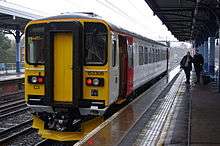
These single-car units were originally built as two-car Class 155 units by Leyland from 1987–88, but were converted by Hunslet-Barclay at Kilmarnock from 1991–92. The class was built for lightly used lines, replacing first generation single coach units. The conversion involved building a new cab at the original inner ends of the vehicles. The layout of the original non-cab ends was subtly different from the original cab end, so the ends are noticeably different, and the vehicle not symmetrical. The new cab is significantly smaller than the original Leyland cab and pushes back into the door area.
Currently operated by
- East Midlands Railway
- Abellio Scotrail
- West Midlands Trains
- Northern Trains
- Transport for Wales
Class 155 Super Sprinter
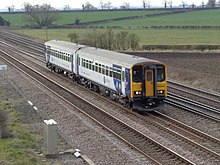
These DMUs were built by British Leyland at Workington (using a body construction technology derived from the Leyland National bus) between 1987 and 1988. Of the original 42 units built, only 7 remain, most were converted into Class 153. They have a top speed of 75 mph (121 km/h).
Currently operated by
Class 156 Super Sprinter
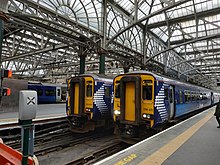
The Class 156 units were built from 1987-89 by Metro-Cammell (now owned by Alstom) at their Washwood Heath Works in Birmingham. The vehicles, like the Class 155s, have a single leaf sliding door at either end of each coach - this feature reflected the anticipated longer journeys (with fewer stops) that the Class 156 was supposed to operate. They have a top speed of 75 mph (121 km/h). They feature medium density (2+2) seating.
Currently operated by:
Class 158 Express Sprinter
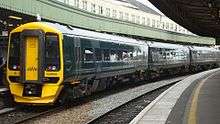
The Class 158 "Express Sprinter" units were built from 1989-92 by BREL at Derby Litchurch Lane Works to replace elderly 'heritage' DMUs and locomotive-hauled passenger trains. Compared with previous members of the Sprinter family, specifically the venerable Class 156 Super Sprinter, the Class 158 is much better suited to longer journeys with fewer stops and provides a much quieter and more comfortable environment. They are fully air-conditioned (except the driver's cabs) with provision for a trolley refreshment service and an increased top speed of 90 mph (145 km/h). They feature medium density (2+2) seating in standard class and, on applicable examples, low density (2+1) seating in first class.
They are mostly fitted with Cummins engines, with the remaining 47 fitted with Perkins engines.
Currently operated by:
- Abellio ScotRail
- East Midlands Railway
- Great Western Railway
- Northern Trains
- South Western Railway
- Transport for Wales
and exported versions for State Railway of Thailand (differences include inward opening slam doors rather than plug doors and 4 carriages rather than 2 or 3 in the UK)
Class 159 South Western Turbo
These 90 mph trains were originally built as 3 car class 158s, but converted before entry into service. Twenty-two 3-car units were built for Network SouthEast's West of England and from London Waterloo to Salisbury, Yeovil and Exeter. They were used to replace Class 50 and Class 47 locomotive-hauled passenger trains. Units tend to operate in six or nine coach formations between Waterloo and Salisbury and in three or six coach formations between Salisbury and Exeter. South West Trains used to operate services from London Waterloo to Paignton, Plymouth and Penzance, but all services west of Exeter were withdrawn at the end of 2009.
Some surplus three coach Class 158 units, which were transferred to the West of England route in 2007, have been refurbished to Class 159 standards, and have been renumbered as Class 159/1
Currently operated by
Proposed
In addition to the production types, there were two types of Sprinter proposed that were in the event not proceeded with.
Class 152
In the early 1990s, as a cost saving measure on underused rural routes, British Rail proposed converting the 2-car Class 156 into single car units, which were named as Class 152. Although the single car Sprinter did go ahead, it was eventually decided to convert the Class 155, which became the Class 153.
Class 157
In the 1990s, Strathclyde Passenger Transport was looking to update the fleet that was used to operate commuter and suburban services in and around Glasgow, with a new Sprinter type intended to be procured, which became Class 157. However, due to British Rail's financial limits at the time leading up to privatisation, these units were not ordered, with Class 170s eventually being procured.
Variations
| Class | Image | Operator | Introduced | Number | Carriages | End Gangways | Notes |
|---|---|---|---|---|---|---|---|
| 150 |  |
|
1984–87 | 137 | 2 (/1 & /2) 3 (/0 & /9) |
No (/0 & /1) Yes (/2 & /9) |
|
| 151 |  |
1985 | 2 | 3 | No | Scrapped in 2004 | |
| 152 | Planned conversion of Class 156 to single car | 1 | Yes | Never built | |||
| 153 | .jpg) |
|
1991–92 | 70 | Converted from Class 155 | ||
| 154 |  |
1985 | 1 | 2 | No | Converted from and back to Class 150 | |
| 155 |  |
1987–88 | 42 | Yes | 35 units converted to Class 153 | ||
| 156 |  |
1987–89 | 114 | ||||
| 157 | Planned regional units | No | Never built | ||||
| 158 |
|
1989–92 | 170 | 2 or 3 | Yes | ||
| 159 | 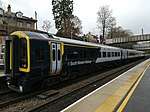 |
1989–93 | 30 | 3 | |||
| 950 | .jpg) |
1985–86 | 1 | 2 | No | Network Rail measurement unit | |
| Thailand ASR | 1990–91 | 12 | 3 | Yes | Built to Thailand's metre gauge | ||
Reception
On many lines, the new units were warmly welcomed. It is important to remember that while the first generation DMUs had given many years of service, in very many cases, they suffered from lack of and/or poor maintenance, with sometimes filthy and worn interiors, and leaking exhaust systems. Ignoring arguments over comfort and style, the mere fact that the trains were clean and new was enough to make them welcome countrywide.
The downside of the new units was the more restricted view through the windows. The Mark 3 bodyshell has a much higher window sill level than the first generation DMUs and moreover the alignment of the windows with the seating positions is poor, a problem common to much Mk 3 derived stock. The view is especially poor for passengers seated nearest to the doors, whose view is obscured by the pockets into which the doors slide when opened, or at the ends of the vehicle. Also unlike the first generation DMUs, the rear of the driver's cab was not glazed, so passengers in the front seats no longer had a view of the track ahead, which was regretted both by railfans and children.
Replacement
As many Sprinters are now 30 years old, train operating companies are beginning to replace them. For example, London Midland decided to replace their Class 150 fleet with Class 172s from 2010.[5]
Class 158s have been augmented or replaced by Class 170 and Class 175 units, allowing these to be cascaded to replace older Sprinters, which in turn replace Pacer trains. Class 158s still operate the five hour journey from Norwich to Liverpool Lime Street and also the four hour Birmingham International to Holyhead journey, replacing Class 175 for use on other long-distance services. Transport for Wales plan to replace their Class 150, 153, and 158 units with brand new CAF Civity diesel multiple units by 2023.
Notes
References
- St John Thomas, David; Whitehouse, Patrick (1990). BR in the Eighties. Newton Abbot: David & Charles. ISBN 0-7153-9854-7.
- Class 150 Sprinter Prototype
- Class 151 Sprinter Prototype
- Class 154 experimental DMU
- "Govia picked to run West Midlands franchise". Railnews. 21 June 2007. Archived from the original on 27 September 2007.